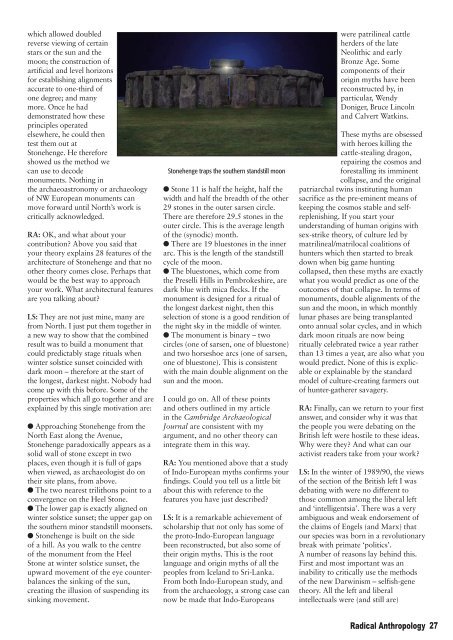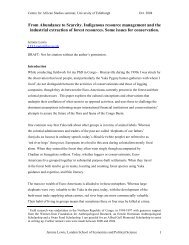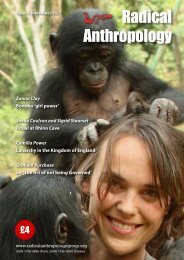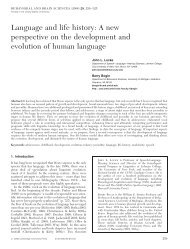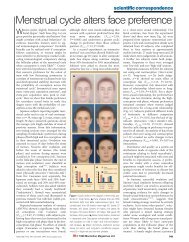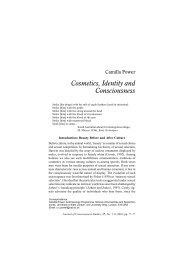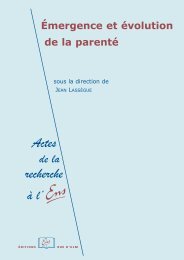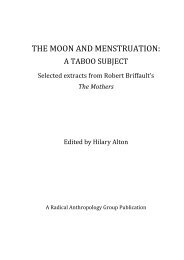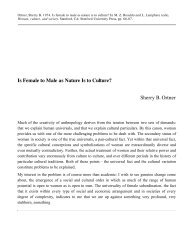The scarcity myth The scarcity myth - Radical Anthropology Group
The scarcity myth The scarcity myth - Radical Anthropology Group
The scarcity myth The scarcity myth - Radical Anthropology Group
Create successful ePaper yourself
Turn your PDF publications into a flip-book with our unique Google optimized e-Paper software.
which allowed doubled<br />
reverse viewing of certain<br />
stars or the sun and the<br />
moon; the construction of<br />
artificial and level horizons<br />
for establishing alignments<br />
accurate to one-third of<br />
one degree; and many<br />
more. Once he had<br />
demonstrated how these<br />
principles operated<br />
elsewhere, he could then<br />
test them out at<br />
Stonehenge. He therefore<br />
showed us the method we<br />
can use to decode<br />
monuments. Nothing in<br />
the archaeoastronomy or archaeology<br />
of NW European monuments can<br />
move forward until North’s work is<br />
critically acknowledged.<br />
RA: OK, and what about your<br />
contribution Above you said that<br />
your theory explains 28 features of the<br />
architecture of Stonehenge and that no<br />
other theory comes close. Perhaps that<br />
would be the best way to approach<br />
your work. What architectural features<br />
are you talking about<br />
LS: <strong>The</strong>y are not just mine, many are<br />
from North. I just put them together in<br />
a new way to show that the combined<br />
result was to build a monument that<br />
could predictably stage rituals when<br />
winter solstice sunset coincided with<br />
dark moon – therefore at the start of<br />
the longest, darkest night. Nobody had<br />
come up with this before. Some of the<br />
properties which all go together and are<br />
explained by this single motivation are:<br />
● Approaching Stonehenge from the<br />
North East along the Avenue,<br />
Stonehenge paradoxically appears as a<br />
solid wall of stone except in two<br />
places, even though it is full of gaps<br />
when viewed, as archaeologist do on<br />
their site plans, from above.<br />
● <strong>The</strong> two nearest trilithons point to a<br />
convergence on the Heel Stone.<br />
● <strong>The</strong> lower gap is exactly aligned on<br />
winter solstice sunset; the upper gap on<br />
the southern minor standstill moonsets.<br />
● Stonehenge is built on the side<br />
of a hill. As you walk to the centre<br />
of the monument from the Heel<br />
Stone at winter solstice sunset, the<br />
upward movement of the eye counterbalances<br />
the sinking of the sun,<br />
creating the illusion of suspending its<br />
sinking movement.<br />
Stonehenge traps the southern standstill moon<br />
● Stone 11 is half the height, half the<br />
width and half the breadth of the other<br />
29 stones in the outer sarsen circle.<br />
<strong>The</strong>re are therefore 29.5 stones in the<br />
outer circle. This is the average length<br />
of the (synodic) month.<br />
● <strong>The</strong>re are 19 bluestones in the inner<br />
arc. This is the length of the standstill<br />
cycle of the moon.<br />
● <strong>The</strong> bluestones, which come from<br />
the Preselli Hills in Pembrokeshire, are<br />
dark blue with mica flecks. If the<br />
monument is designed for a ritual of<br />
the longest darkest night, then this<br />
selection of stone is a good rendition of<br />
the night sky in the middle of winter.<br />
● <strong>The</strong> monument is binary – two<br />
circles (one of sarsen, one of bluestone)<br />
and two horseshoe arcs (one of sarsen,<br />
one of bluestone). This is consistent<br />
with the main double alignment on the<br />
sun and the moon.<br />
I could go on. All of these points<br />
and others outlined in my article<br />
in the Cambridge Archaeological<br />
Journal are consistent with my<br />
argument, and no other theory can<br />
integrate them in this way.<br />
RA: You mentioned above that a study<br />
of Indo-European <strong>myth</strong>s confirms your<br />
findings. Could you tell us a little bit<br />
about this with reference to the<br />
features you have just described<br />
LS: It is a remarkable achievement of<br />
scholarship that not only has some of<br />
the proto-Indo-European language<br />
been reconstructed, but also some of<br />
their origin <strong>myth</strong>s. This is the root<br />
language and origin <strong>myth</strong>s of all the<br />
peoples from Iceland to Sri-Lanka.<br />
From both Indo-European study, and<br />
from the archaeology, a strong case can<br />
now be made that Indo-Europeans<br />
were patrilineal cattle<br />
herders of the late<br />
Neolithic and early<br />
Bronze Age. Some<br />
components of their<br />
origin <strong>myth</strong>s have been<br />
reconstructed by, in<br />
particular, Wendy<br />
Doniger, Bruce Lincoln<br />
and Calvert Watkins.<br />
<strong>The</strong>se <strong>myth</strong>s are obsessed<br />
with heroes killing the<br />
cattle-stealing dragon,<br />
repairing the cosmos and<br />
forestalling its imminent<br />
collapse, and the original<br />
patriarchal twins instituting human<br />
sacrifice as the pre-eminent means of<br />
keeping the cosmos stable and selfreplenishing.<br />
If you start your<br />
understanding of human origins with<br />
sex-strike theory, of culture led by<br />
matrilineal/matrilocal coalitions of<br />
hunters which then started to break<br />
down when big game hunting<br />
collapsed, then these <strong>myth</strong>s are exactly<br />
what you would predict as one of the<br />
outcomes of that collapse. In terms of<br />
monuments, double alignments of the<br />
sun and the moon, in which monthly<br />
lunar phases are being transplanted<br />
onto annual solar cycles, and in which<br />
dark moon rituals are now being<br />
ritually celebrated twice a year rather<br />
than 13 times a year, are also what you<br />
would predict. None of this is explicable<br />
or explainable by the standard<br />
model of culture-creating farmers out<br />
of hunter-gatherer savagery.<br />
RA: Finally, can we return to your first<br />
answer, and consider why it was that<br />
the people you were debating on the<br />
British left were hostile to these ideas.<br />
Why were they And what can our<br />
activist readers take from your work<br />
LS: In the winter of 1989/90, the views<br />
of the section of the British left I was<br />
debating with were no different to<br />
those common among the liberal left<br />
and ‘intelligentsia’. <strong>The</strong>re was a very<br />
ambiguous and weak endorsement of<br />
the claims of Engels (and Marx) that<br />
our species was born in a revolutionary<br />
break with primate ‘politics’.<br />
A number of reasons lay behind this.<br />
First and most important was an<br />
inability to critically use the methods<br />
of the new Darwinism – selfish-gene<br />
theory. All the left and liberal<br />
intellectuals were (and still are)<br />
<strong>Radical</strong> <strong>Anthropology</strong> 27


